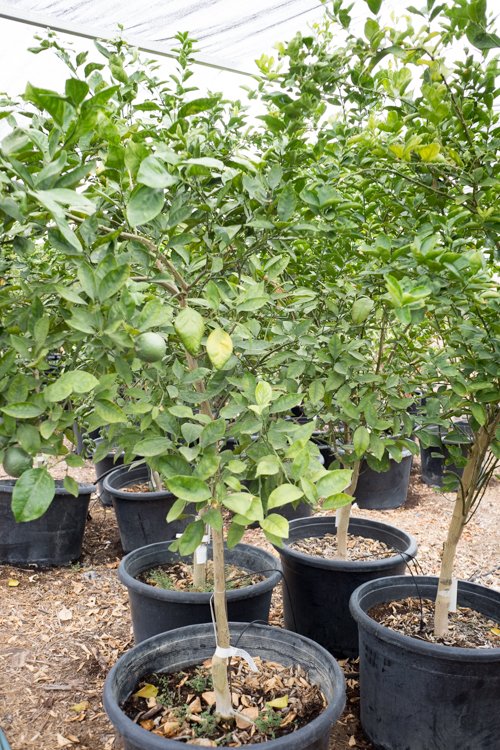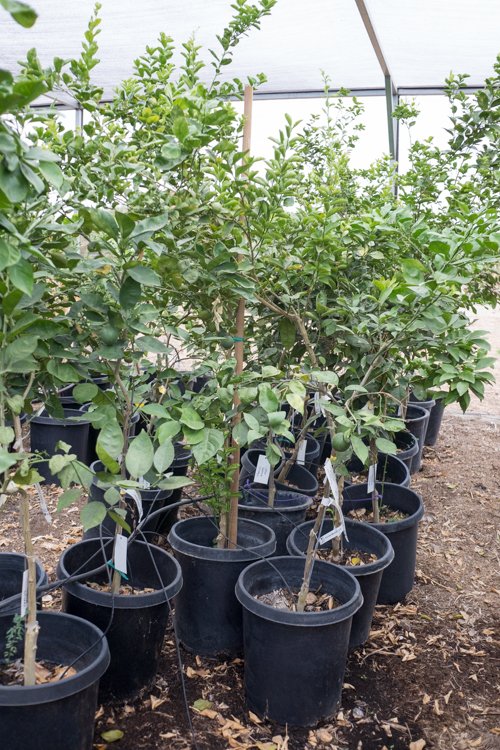Valencia Orange Tree
Searching for an orange tree variety to grow in the desert or elsewhere in California?
We want to introduce you to the Valencia orange tree!
It's one of the best orange trees to grow in the desert due to its tolerance to heat, a wide range of soil types, and drought resistance, which surpasses that of the average orange tree.
And, of course, it comes as a huge plus that it produces sweet and juicy Valencia oranges, prized for their use in making orange juice.
Botanical name: Citrus sinensis ‘Valencia’
Other names: Valencia Sweet Orange
Large Valencia orange trees for sale at our nursery
TABLE OF CONTENTS
Valencia Orange tree Appearance
Valencia orange trees are beautiful evergreen trees that have deep green leaves throughout the year. When they produce fruit, the bright oranges contrast nicely with the glossy green leaves.
Upright growth pattern. Grows to 15-25 feet tall and 10-20 feet wide, although many people keep it shorter for easier orange harvest. Dense branches and leaves make it a good shade tree.
Small, white flowers with a strong, pleasant fragrance.
Followed by round Valencia oranges, which are famous for their sweetness and juiciness.
When they first appear, they are green, and as they ripen, turn orange. Some Valencia orange varieties have oranges that stay green or revert to green. Few seeds, usually less than 10 per fruit.
Valencia Orange tree Landscaping Tips
Valencia oranges are widely used in California and the US in general for producing orange juice. They are sweet, have high water content, and have very few seeds. Outside of juicing, oranges have a wide range of culinary and medicinal uses.
Popular in California and the Southwest because of its tolerance for coastal and desert environments. Valencia orange trees are more drought-tolerant than the average orange tree.
Valencia orange trees usually fruit more than once a year. It’s also the only orange tree that produces a crop in the summer.
Ripe oranges hold up well on the tree. No need to pick immediately once they're ripe.
Keep it in a container and over winter indoors if your region experiences below-freezing temperatures.
Prune weak or diseased branches throughout the year. The heaviest pruning should be done in late winter to keep trees at a manageable size.
Great tree for adding fragrance to the garden as well as attracting pollinators such as birds, bees, and butterflies.
Self-fertile. You only need one Valencia orange tree to produce oranges.
Valencia Orange tree Origin
Although Valencia, Spain has its own renowned orange trees, here in the US, when we say "Valencia orange tree,” we are referring to the orange tree that was developed by William Wolfskill in Santa Ana, California.
Valencia Orange tree Care
Soil: Fertile, well-draining soil that is slightly acidic to acidic. Use a fertilizer formulated for citrus trees.
Temperature: Can withstand temperatures down to 30 degrees Fahrenheit for a short period of time. If you live in a climate that experiences cold winters, we recommend overwintering them indoors.
Water: Moderate water needs. Regular deep watering, especially when blooming and fruiting and during heat waves. Do not allow soil the completely dry out for a long period of time. More drought tolerant once mature.
Sun: Full sun
Valencia Orange tree Problems
Pests: Valencia orange trees may attract pests such as aphids, mealybugs, psyllid, and scale.
For aphids, blast them off with water if the infestation is light. Otherwise, use horticultural oil or soapy water.
To remove mealybugs, use insecticidal soap or apply rubbing alcohol directly to the area of the infestation using a cotton swab.
To remove scales, pick them off or use horticultural oil or insecticidal soap. Horticultural oil will kill both crawlers and adults with direct contact. Insecticidal soap is better used to target only the crawlers.
Whenever using any kind of pesticide, be aware that it can damage the plant if the temperatures are in the 80s or above.
Signs of overwatering: Root rot, drooping leaves
Signs of too little water: Browning and drying leaves
Signs of too much sun: Leaf burn, fading color
Signs of too little sun: Etiolation, stunted growth, few flowers
Valencia Orange tree Propagation
The easiest way to propagate a Valencia orange tree is through cuttings. Obtain 1-foot-long semi-hardwood cuttings with a sharp tool and plant them in the soil. Keep soil moist until it's well established.
FAQ
HOW MUCH DOES a Valencia Orange Tree COST?
At our nursery, Valencia orange trees cost $150 for a 15-gallon container, and $325 for a 24” box.
Prices are subject to change. Please contact us for the most up-to-date information on pricing. We may have larger sizes available. We provide installation services locally at a separate cost.
What do Valencia oranges taste like?
Valencia oranges have a lot of flavor. They’re very sweet, and also a little sour. They’re great for snacking as well as juicing.
How big does a Valencia orange tree get?
It can grow to 25 feet, although many people keep the tree pruned so that it stays to around 10 feet.
Can I get oranges from one Valencia orange tree?
Yes, Valencia orange trees are self-pollinating. One blossom contains both male and female parts to allow self-pollination.
How long does it take for a Valencia orange tree to bear fruit?
Most orange trees start to bear fruit when they're about 3 years old.
Summary
| SIZE (H X W) | 15-25 feet X 10-20 feet |
|---|---|
| FLOWER COLOR | White |
| FLOWER SEASON | Spring to Summer |
| EXPOSURE | Full Sun |
| WATER | Moderate |
| GROWTH RATE | Moderate |
| HARDINESS | 28º F, USDA Zone 9 |
| PRUNING | As needed |


